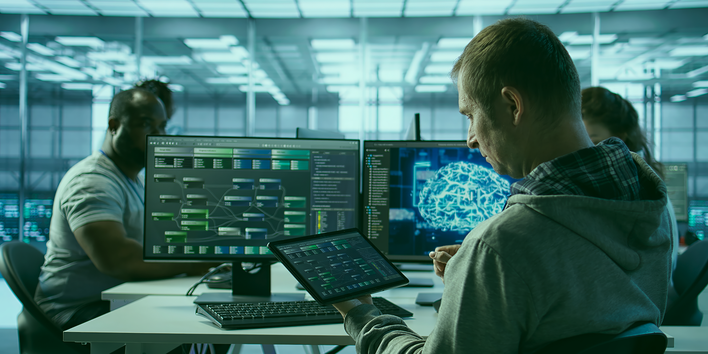In today’s hyper-connected world, where milliseconds can determine market advantage and complexity compounds by the hour, enterprises are under intense pressure to act with precision and speed. Coordinating decisions across globally distributed teams, supply chains, and customer touchpoints has become a strategic challenge. Traditional manual processes and centralized systems no longer scale. And while isolated AI tools may optimize parts of the business, they rarely drive enterprise-wide responsiveness.
What’s needed now is more than automation; it’s orchestration. A shift from siloed intelligence to distributed autonomy. A new architecture where intelligent agents can sense change, make context-aware decisions, and collaborate across systems without waiting for human input or top-down control.
That shift is already underway. Enterprise AI has evolved from automating tasks to enabling intelligent, adaptive actions across every business function in real-time. At the center of this evolution are multi-agent systems: decentralized networks of autonomous AI agents that learn, coordinate, and act independently yet collaboratively.
These agents operate like digital teams, driving operational resilience, self-healing processes, and cross-functional collaboration at unprecedented scale.
The urgency to adopt multi-agent systems has never been greater. From adaptive operations that respond instantly to market shifts, to autonomous manufacturing workflows and decentralized decisions in retail, these systems are no longer experimental; they are foundational to the future of enterprise AI.
In this blog, we’ll unpack what multi-agent systems are, how they work, and why they’re the key to scaling intelligence and responsiveness across the enterprise.
What are multi-agent systems? A clear definition
Imagine a system where dozens, or even hundreds, of intelligent agents operate independently yet in harmony, each making decisions, sharing insights, and adapting to changes in real time. This is the essence of multi-agent systems, a powerful AI framework that enables enterprises to solve complex, evolving problems with agility and precision. Understanding how these systems function is key to unlocking new levels of operational excellence and innovation in today’s fast-paced business landscape.
Define multi-agent systems (MAS)
Multi-agent systems (MAS) are AI architectures composed of multiple autonomous agents that work together either cooperatively or competitively to achieve individual or shared objectives. Each agent operates independently, with its own goals, data inputs, and decision-making logic. Yet, they’re capable of real-time coordination, negotiation, and communication with other agents within the system.
Unlike monolithic AI agents designed to handle a single task, multi-agent systems structures intelligence across distributed agents. This allows the system to adapt dynamically to changes, balance workload across resources, and solve multi-dimensional problems with contextual awareness.
In enterprise scenarios, multi-agent system can manage complex environments, such as distributed manufacturing, or omnichannel operations, where decisions must be made simultaneously across multiple domains, often with competing constraints.
How multi-agent systems differ from traditional AI and rule-based systems
To fully grasp multi-agent systems, it’s helpful to contrast it with earlier AI paradigms.
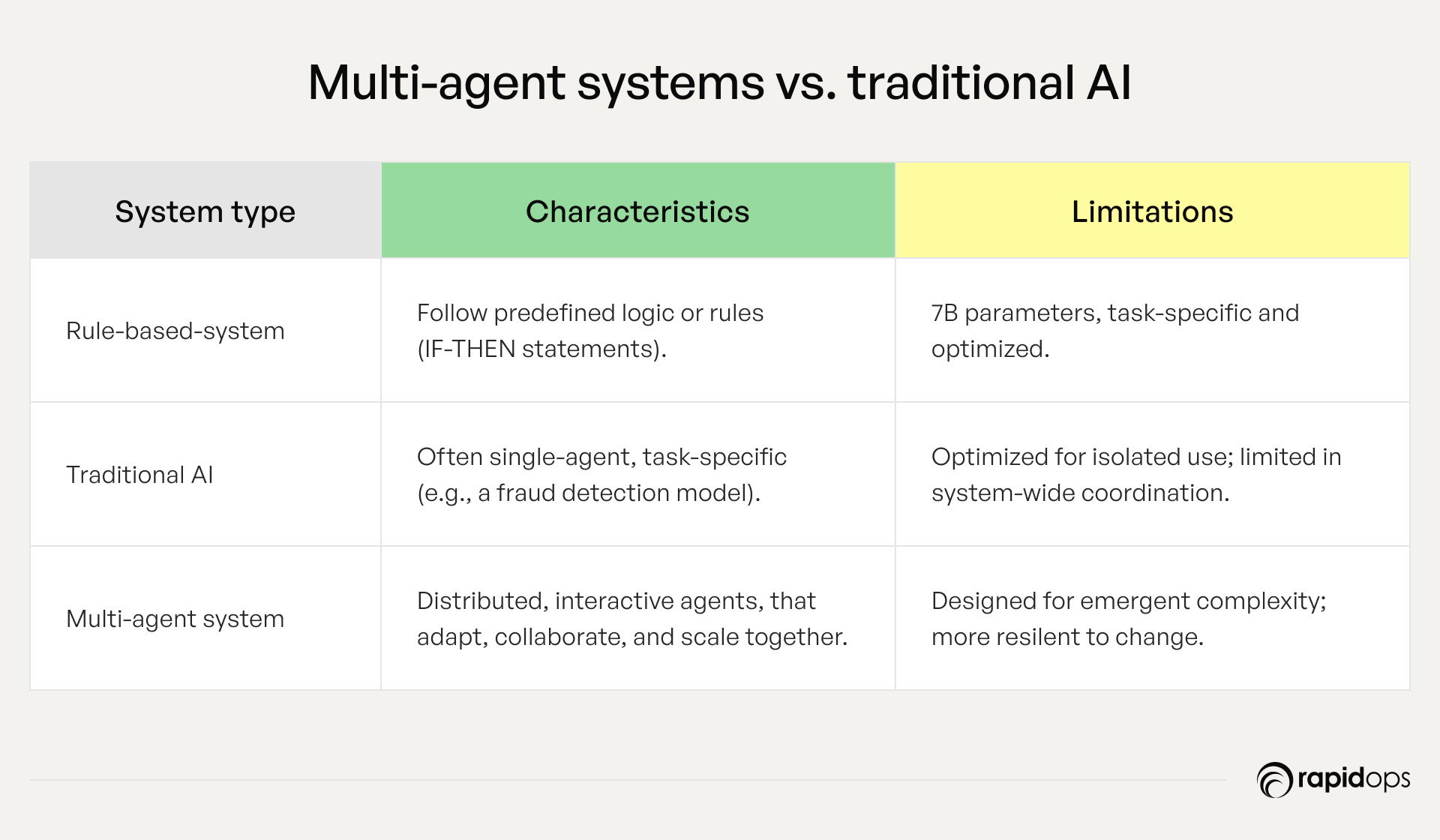
While traditional AI agents remain valuable for focused, high-accuracy tasks, MAS enables broader orchestration, allowing enterprises to manage interdependencies, negotiate trade-offs, and respond collectively across domains.
This evolution isn’t about replacement; it’s about architectural fit. Single-agent AI works well in narrowly scoped domains; multi-agent systems excels when tasks are interrelated, distributed, and require continuous collaboration or negotiation between systems.
Where multi-agent systems fit within the broader AI landscape
Multi-agent systems represent a crucial evolution in the AI landscape, bridging the gap between narrow AI and more generalized, adaptive intelligence. They extend AI’s reach beyond siloed applications, forming the backbone for enterprise-wide, real-time decision-making.
Here’s how multi-agent systems integrates within the broader AI stack:
- Foundation models: Multi-agent systems can incorporate generative or predictive models within each agent (e.g., an agent using LLMs to interpret documents).
- Edge + IoT integration: Multi-agent systems can control decentralized physical systems, factories, fleets, and sensors by assigning agents to each operational node.
- Enterprise platforms: Multi-agent systems orchestrates processes across ERP, CRM, supply chain, and customer experience platforms by enabling agent-to-agent coordination.
As AI systems mature, multi-agent systems becomes the architecture that unifies diverse capabilities, analytics, automation, and personalization, as well as optimization, into a cohesive, intelligent enterprise fabric. It reflects how modern businesses operate: decentralized yet interconnected, agile yet coordinated.
Single agent vs. multi-agent systems: A strategic comparison
When designing intelligent systems for your enterprise, choosing the right architecture can define the success or limitations of your solution. Single-agent and multi-agent systems represent two fundamentally different approaches to automation and decision-making, each with unique strengths and challenges.
Understanding how they differ in autonomy, scalability, fault tolerance, and coordination is essential to align technology with your business goals. This comparison will help you navigate these trade-offs strategically, empowering you to build systems that not only solve today's problems but also adapt and scale for tomorrow’s complexities.
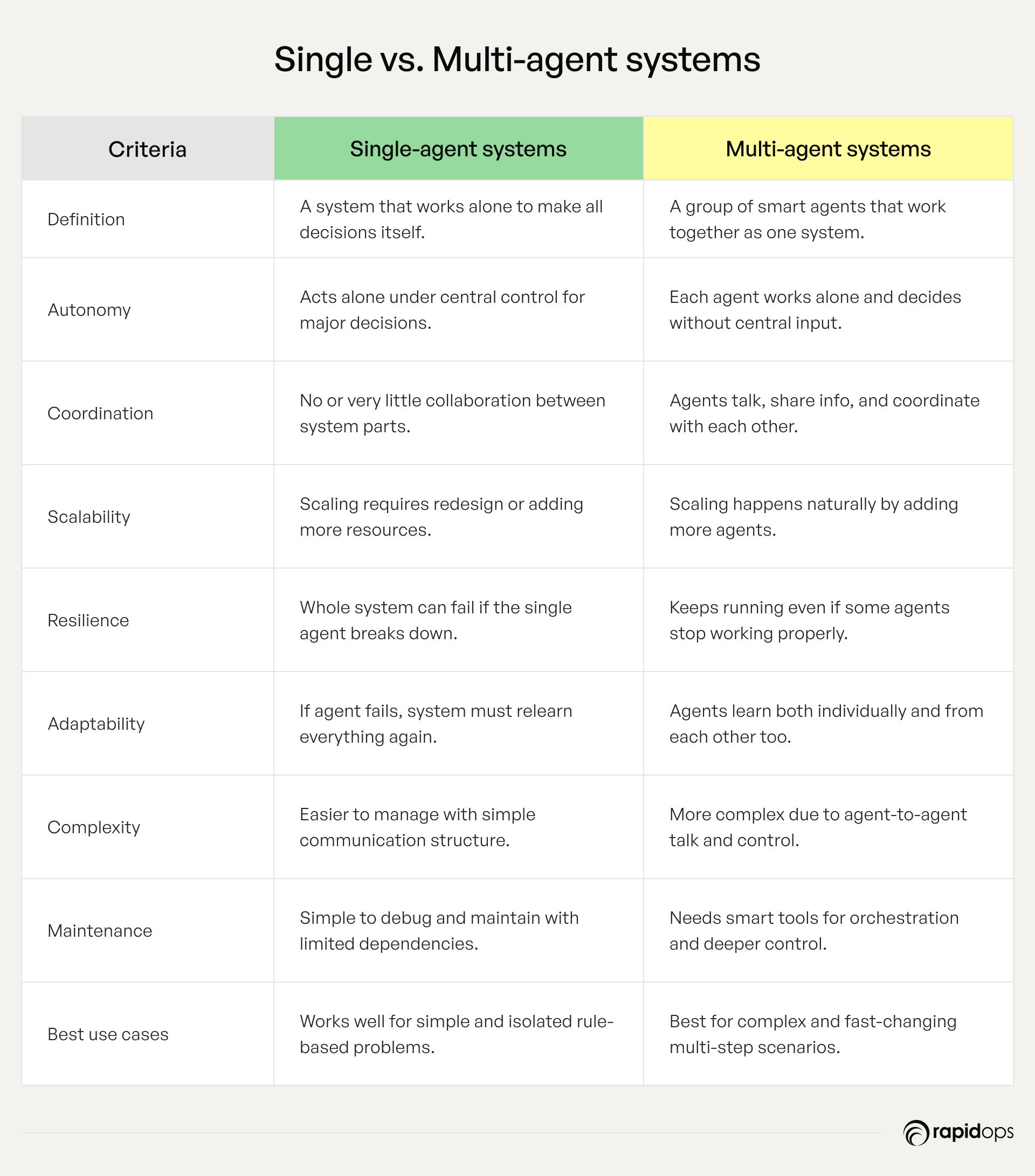
Why multi-agent systems matter for modern enterprises
Organizations are becoming dynamic, interconnected networks where traditional, linear systems can no longer keep pace with the demands of real-time decision-making, operational agility, and continuous innovation. This is where multi-agent systems step in, not as a replacement, but as a strategic layer that augments how organizations sense, respond, and adapt at scale.
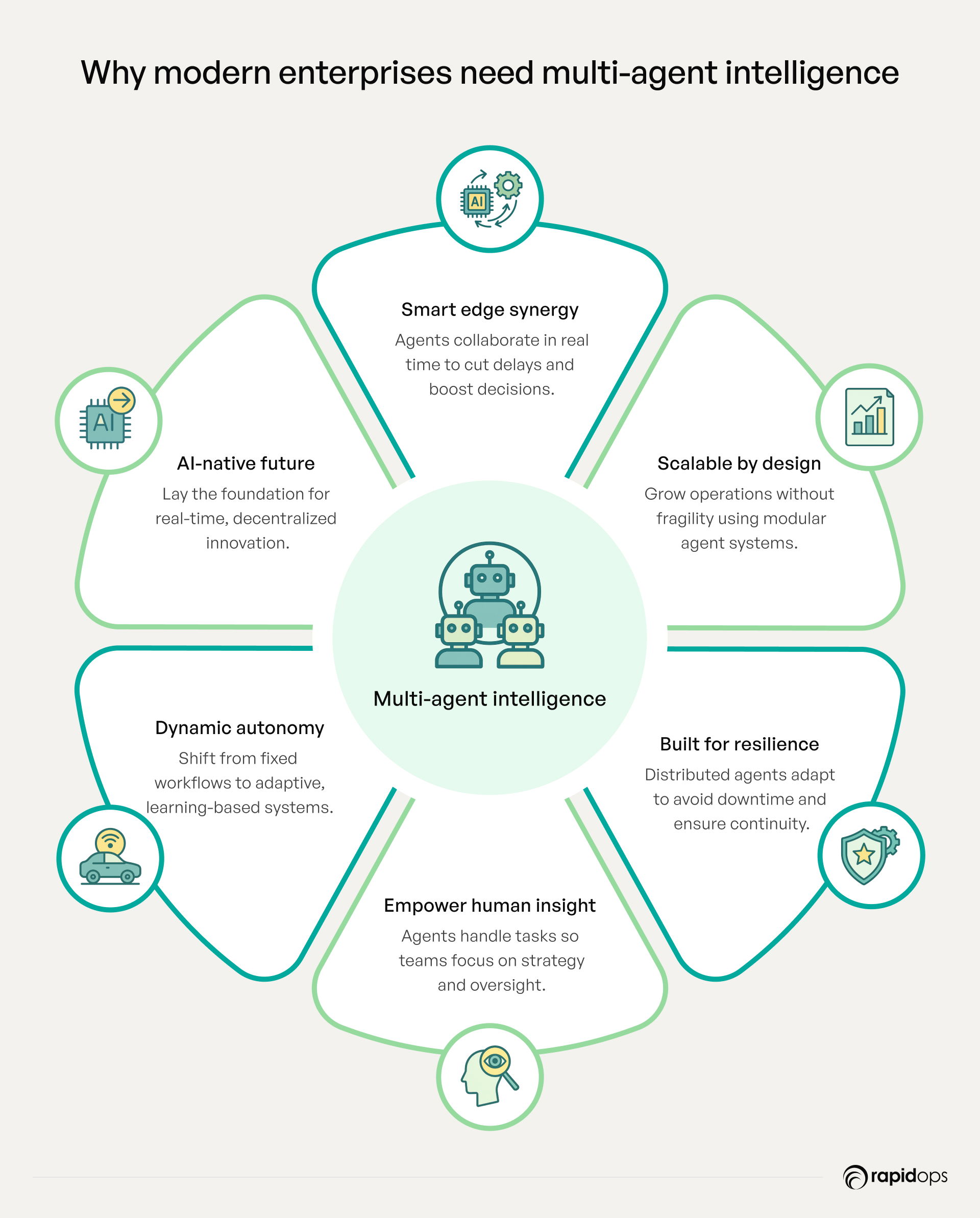
1. Orchestrated collaboration at the edge of complexity
Multi-agent systems allow autonomous agents each with distinct roles, capabilities, and objectives, to work in tandem. Rather than relying on centralized control, they negotiate, collaborate, and adapt in real time. For modern enterprises, this means fewer bottlenecks, faster decisions, and intelligent coordination across distributed operations.
2. Scalability without fragility
As your enterprise grows, complexity shouldn’t come at the cost of resilience. Multi-agent systems architectures are inherently modular, allowing you to scale horizontally while maintaining system integrity. Each agent can evolve independently, enabling continuous optimization without disrupting the entire operation.
3. Built-in resilience and fault tolerance
In today’s volatile environment, system downtime or failure cascades are unacceptable. Multi-agent systems distribute control and intelligence, so if one agent underperforms or fails, others adapt. This architecture ensures graceful degradation, self-healing capabilities, and business continuity even under stress.
4. Human and machine synergy, reimagined
Multi-agent systems do not replace human decision-makers; they empower them. By delegating repetitive, time-sensitive decisions to intelligent agents, human teams are freed to focus on higher-order strategic thinking. This model accelerates outcomes while preserving human oversight.
5. From process automation to intelligent autonomy
Multi-agent systems extend beyond automating static workflows. They enable systems to perceive changing environments, learn from interactions, and dynamically adjust. Whether in supply chains, logistics, customer experience, or industrial operations, multi-agent systems turn static processes into adaptive networks.
6. Future-ready architecture for enterprise innovation
Enterprises investing in multi-agent systems today are not just improving current operations, they are laying the groundwork for AI-native ecosystems. This shift opens doors to real-time optimization, decentralized intelligence, and competitive advantage that compounds over time.
How multi-agent systems work under the hood
At the core of multi-agent systems lies a dynamic network of autonomous entities, known as agents, that perceive their environment, make decisions independently, and collaborate or compete to achieve system-wide objectives. These systems don’t just automate tasks; they orchestrate intelligence across distributed components in real time. Let’s explore the inner mechanics that make them work.
1. Autonomous decision-making
Each agent operates independently, governed by its own set of goals, policies, and reasoning capabilities. Unlike centralized systems, there’s no master controller dictating behavior. Agents interpret their environment and decide what to do based on local data, heuristics, or learned strategies. This autonomy makes multi-agent systems highly adaptive in complex, evolving scenarios.
2. Environment perception and sensing
Agents continuously gather data from their surroundings using sensors or system APIs. This includes information about physical conditions (in IoT or robotics systems), system states (in software environments), or human inputs. These perceptions form the basis of real-time decision-making and reactive behavior.
3. Communication and information exchange
Agents share information about goals, states, and actions through defined communication protocols. This decentralized communication architecture enables agents to coordinate their efforts, avoid conflicts, and align with common objectives without relying on a central data hub. Whether direct (peer-to-peer) or indirect (via shared environments), this exchange is what fuels intelligent collaboration.
4. Coordination through shared protocols
Coordination ensures that agents work in harmony rather than at cross purposes. This is often achieved using distributed algorithms that define how agents negotiate, delegate, or synchronize tasks. For example, one agent might reschedule a delivery while another adjusts inventory or routing operations, without requiring manual intervention.
5. Distributed control and decentralized governance
Multi-agent systems thrives on distributed control. No single agent holds complete authority. Instead, agents make localized decisions that contribute to the system’s global goals. This decentralized structure reduces bottlenecks, enhances fault tolerance, and improves scalability, particularly in large enterprise systems.
6. Goal orientation and behavioral modeling
Every agent operates with an internal goal model, either static (predefined objectives) or dynamic (adaptive based on real-time inputs). Agents can reprioritize tasks, collaborate to achieve shared milestones, or renegotiate their roles based on new information and insights. This enables the system to remain focused and resilient in the face of changing conditions.
7. Learning and adaptation
Many multi-agent system implementations incorporate learning algorithms, allowing agents to enhance their performance over time. Through reinforcement learning, supervised inputs, or even experience-based heuristics, agents evolve their decision-making models. This adaptive capacity allows multi-agent system to function effectively in uncertain or unpredictable environments.
8. Emergent intelligence
The most powerful aspect of multi-agent systems is emergent behavior, system-level intelligence that arises from the interaction of individual agents. No single agent is programmed to create this intelligence; instead, it emerges organically as agents collaborate to solve problems. This is how multi-agent systems outperforms traditional software: it learns, scales, and innovates without requiring reprogramming.
Multi-agent systems function as a living network of smart, autonomous decision-makers that observe, act, and learn, often in real-time. The beauty lies not in any single agent’s intelligence, but in how they interact, adapt, and collectively shape solutions that are far more resilient and context-aware than traditional systems can offer.
Types of multi-agent architectures: Centralized, decentralized, and hybrid
Behind every intelligent system lies a choice about how autonomous agents should collaborate to drive outcomes greater than the sum of their parts. This is more than a technical decision; it serves as a blueprint for scale, resilience, and adaptability.
The architecture you choose, centralized, decentralized, or hybrid, shapes how intelligence flows, how quickly your enterprise adapts, and how confidently your teams respond to dynamic, real-world conditions. In fast-moving environments, understanding these architectural foundations empowers more informed, forward-looking decisions.
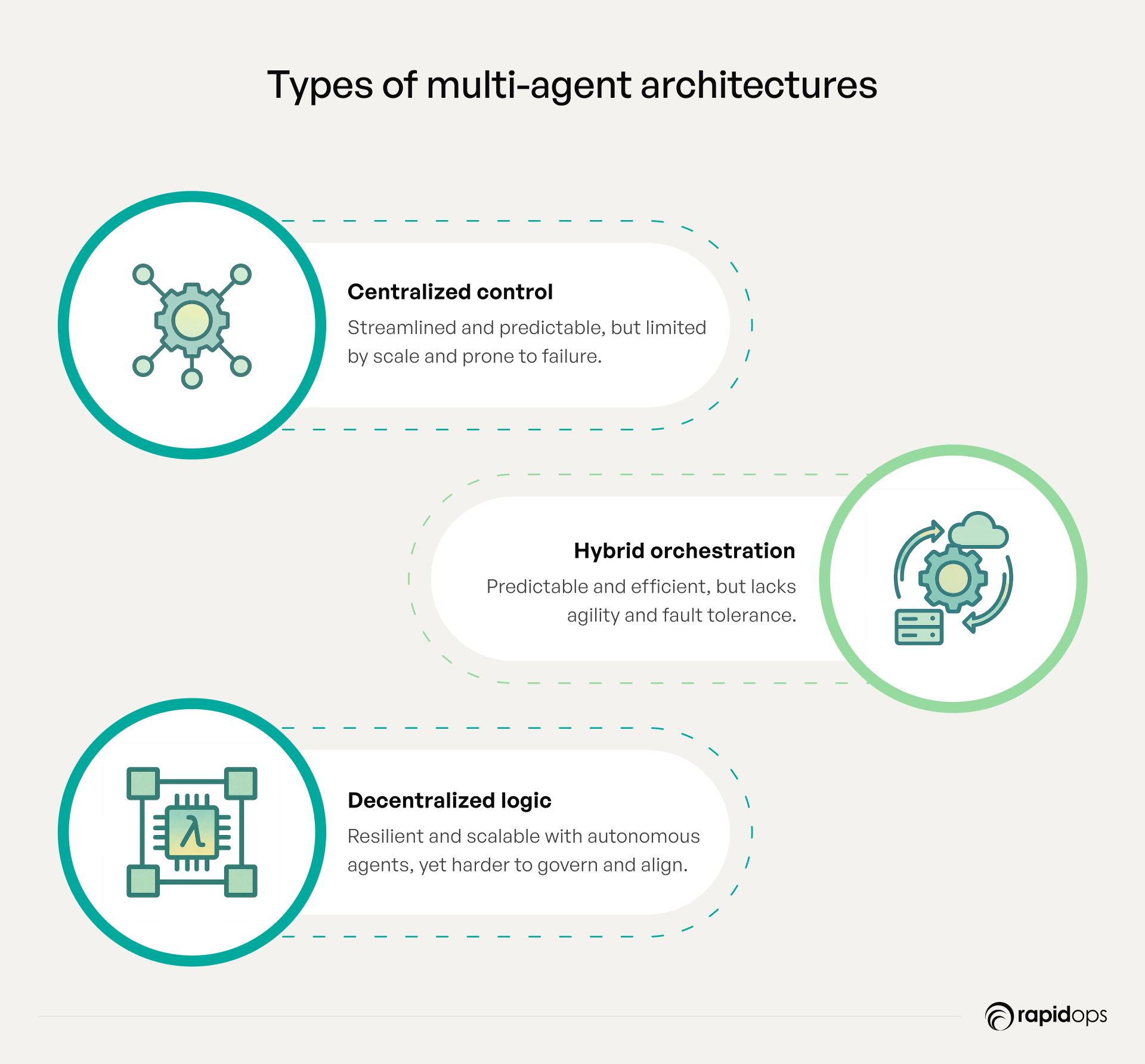
1. Centralized architecture: Control through coordination
In a centralized multi-agent systems, a single coordinating agent or entity oversees the entire system’s behavior. All agents operate under the direction or supervision of this central authority, which manages planning, resource allocation, and decision-making.
This approach offers several advantages:
- Simplicity and control: It’s easier to monitor, update, and debug.
- Efficiency: Streamlined communication can lead to faster convergence in well-defined scenarios.
- Predictability: The flow of operations remains tightly governed, reducing ambiguity.
However, its limitations make it less suitable for dynamic or large-scale environments:
- Scalability constraints: As the number of agents increases, the central node becomes a bottleneck.
- Single point of failure: If the central coordinator fails, the system may collapse.
- Reduced adaptability: The rigidity of the structure can hinder responsiveness in real-time conditions.
Best fit: Structured, low-variability tasks such as routine workflows, centralized dispatching, or isolated systems with minimal external dependencies.
2. Decentralized architecture: Distributed autonomy at scale
In decentralized architectures, there is no single point of control. Each agent acts independently, coordinating with nearby agents or responding to local context. Decisions emerge organically through interaction, rather than being imposed from above.
Key benefits include:
- High fault tolerance: No single node’s failure brings down the system.
- Scalability: Systems can grow organically as more agents are added.
- Adaptability: Agents can quickly respond to local or unexpected conditions without waiting for central approval.
This model, however, introduces new challenges:
- Complex coordination: Ensuring agents align toward global objectives is more difficult.
- Consistency trade-offs: Without centralized oversight, synchronization issues or unexpected emergent behaviors can arise.
- Higher development overhead: Building and maintaining decentralized logic requires deeper domain modeling.
Best fit: Dynamic, distributed systems like traffic systems, decentralized customer service networks operating across geographies and time zones.
3. Hybrid architecture: The best of both worlds
Hybrid architectures blend centralized oversight with decentralized execution. A central agent may provide high-level direction, set shared goals, or enforce strategic guardrails, while individual agents operate independently within their local context.
This approach enables enterprises to balance control with flexibility:
- Strategic alignment: A central layer ensures that distributed agents are working toward common outcomes.
- Operational resilience: Local autonomy supports responsiveness and fault tolerance.
- Scalable governance: Organizations can enforce compliance while empowering agents to act in real time.
Hybrid models are increasingly common in real-world enterprise deployments, from manufacturing lines where local robots coordinate tasks to logistics networks where regional hubs operate under central planning.
Best fit: Large enterprises that operate across complex, distributed environments but still require oversight, compliance, and system-wide optimization.
Choosing the right multi-agent architecture isn’t about picking a model; it’s about aligning structure with strategy. When agents operate in sync with your business realities, they don’t just solve problems; they unlock momentum, flexibility, and long-term intelligence.
How AI agents coordinate, communicate, and evolve together
In multi-agent systems, intelligence emerges through collaboration. As agents coordinate, communicate, and adapt in real time, they generate outcomes that reflect a deeper, collective understanding, turning interaction into intelligent, system-wide behavior.
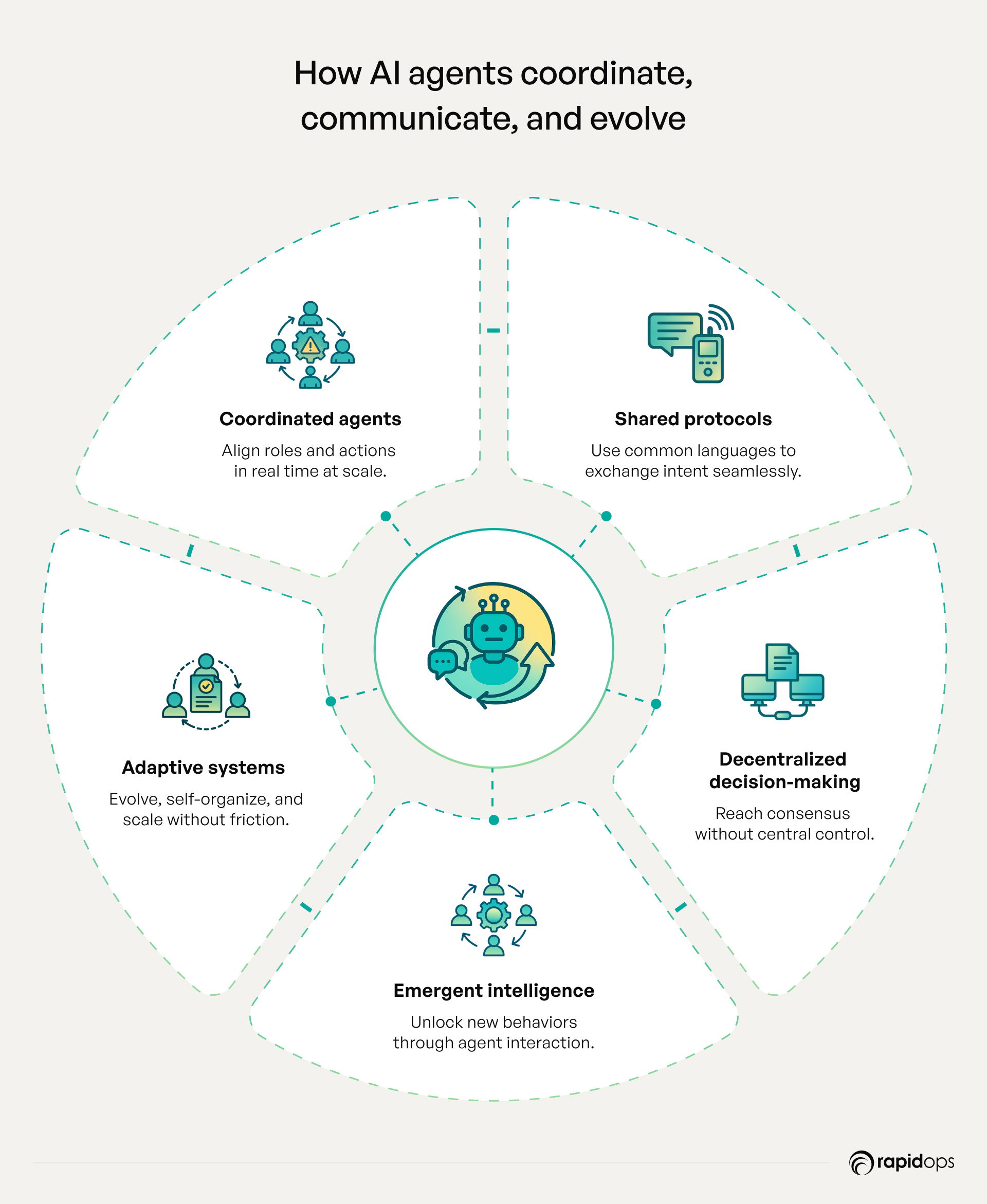
Agent coordination models
Coordination defines how agents assign roles, share responsibilities, and align their actions in real time. In distributed environments, agents may specialize in tasks, take on rotating roles, or operate in parallel, yet still stay in sync. Whether managing autonomous drones or optimizing warehouse operations, effective coordination ensures each agent contributes to the bigger objective without duplication or interference.
Communication protocols and languages
Agents rely on structured messaging systems to exchange information, intentions, and status updates. Standardized protocols like FIPA-ACL and KQML help agents interpret each other’s messages accurately, whether requesting data, making commitments, or signaling changes. These shared “languages” form the backbone of cooperation, especially when agents are built by different systems or vendors.
Team behavior and distributed consensus
When there’s no central controller, agents must agree on next steps, whether through voting, negotiation, or swarm logic. This distributed consensus allows teams of agents to dynamically assign resources, resolve conflicts, and adapt goals in real time. The system behaves more like a self-steering organism than a rigid program.
Emergent behaviors through interaction
One of the most compelling aspects of multi-agent systems is emergent intelligence, unexpected, useful behaviors that arise from simple rules and local decisions. Think of ant colonies or bird flocks: no single agent controls the whole, yet the group displays problem-solving capabilities that seem intentional. In MAS, this can lead to innovative outcomes that evolve naturally through interaction.
Conflict resolution and cooperation strategies
Agents often encounter conflicting goals, limited resources, or ambiguous data. Smart systems are built in ways to resolve these issues through prioritization, mediation, or even cooperative task-switching. These mechanisms ensure that individual success doesn’t come at the cost of overall system performance.
Dynamic adaptation and self-organization
Multi-agent systems thrive in dynamic environments because they can self-organize. When goals shift or external conditions change, agents can restructure their groups, reassign roles, or rewrite their local rules without human intervention. This adaptability is key for real-time systems in logistics, security, finance, and beyond.
Scalability of intelligence
As more agents join the system, coordination and communication must scale without bottlenecks. MAS architecture supports decentralized decision-making, enabling growth without loss of performance. Whether deploying 10 or 10,000 agents, the system maintains stability, responsiveness, and speed, making it ideal for complex enterprise environments.
Real-time learning and adaptation in multi-agent systems
Once agents begin to coordinate and communicate effectively, their true potential emerges through real-time learning, transforming collective interaction into continuous intelligence.
In dynamic enterprise environments, static decision models fall short. Modern multi-agent systems are built to evolve in motion, learning directly from operational data as events unfold. Instead of relying on offline retraining, agents continuously update their understanding of shifting customer behaviors, supply fluctuations, and system constraints.
This adaptability is driven by real-world feedback. Using reinforcement-style learning, agents refine their strategies based on outcomes, improving not just response time but decision quality with every cycle. The system doesn’t just keep up, it gets better.
Adaptation also extends beyond the individual. Through real-time sensing, agents adjust to changing contexts, such as traffic delays, demand spikes, or inventory shortfalls, on the fly. And through system-wide knowledge sharing, each agent’s insight becomes a shared advantage, amplifying learning across the network.
These real-time feedback loops create a self-correcting system. Every action taken is interpreted and folded back into future decisions instantly, closing the learning cycle where it happens, not after the fact.
Even roles aren’t fixed. Agents can dynamically shift focus based on evolving business priorities. An agent managing order fulfillment today may transition to demand forecasting tomorrow, all without manual intervention or system reconfiguration.
This is what elevates multi-agent systems from static automation to adaptive, living ecosystems, ones that learn, improve, and align more deeply with your enterprise goals every day.
Industry applications of multi-agent systems
In retail, manufacturing, and distribution, operational efficiency hinges on intelligent coordination. Multi-agent systems bring AI agents together to optimize inventory, streamline logistics, and automate production, transforming disjointed processes into agile, responsive workflows that reduce delays, boost output, and keep your business ahead.
Retail: Intelligent return management
Returns remain a hidden cost center in retail, impacting margins, customer satisfaction, and inventory accuracy. Multi-agent systems (MAS) bring intelligence and orchestration to this fragmented process. Each agent operates autonomously yet collaboratively: a validation agent confirms return eligibility by analyzing policies, order history, and product metadata. A logistics agent optimizes pickup or drop-off based on geography, urgency, and carrier availability.
Inspection agents assess item condition via images and context to automate routing restock, refurbish, or recycle. Inventory agents instantly adjust stock levels to maintain omnichannel accuracy. Finance agents automate refunds and credits, cross-checking for fraud or exceptions. Throughout, a customer experience agent keeps the buyer informed, reducing support overhead and improving trust. Multi-agent systems transforms returns from a cost liability into a seamless, proactive, and scalable operation, one that builds post-purchase loyalty and preserves operational agility.
Manufacturing: Distributed quality assurance
In high-volume manufacturing, quality assurance must evolve from isolated inspections to an intelligent, distributed system. Multi-agent systems (MAS) empower this shift by embedding autonomous agents throughout the production environment, each one tuned to monitor materials, machines, and assembly processes in real-time.
Instead of waiting for post-production checks, these agents detect subtle deviations, such as a change in material thickness or misalignment on the assembly line, as they occur. They collaborate instantly to trace anomalies, identify root causes, flag affected units, and alert supervisors or automated systems before the issue spreads.
This creates a continuous, self-correcting quality loop that reduces rework, boosts yield, and ensures compliance with strict standards. Leaders gain real-time visibility across every node of production while minimizing downtime and human error. Multi-agent systems turns quality into a proactive, scalable function, transforming manufacturing from reactive control to predictive excellence that aligns with customer expectations and market precision.
Distribution: Autonomous fulfillment operations
In modern distribution centers, efficiency isn’t just about speed; it’s about intelligent orchestration. Multi-agent systems enable this by turning fragmented fulfillment workflows into a dynamic, autonomous operation that adapts in real time.
Within a multi-agent powered warehouse, specialized agents continuously monitor order volumes, worker availability, robotics status, and shipping deadlines. When demand surges, these agents reallocate tasks, prioritize critical orders, and optimize picking paths on the fly.
Inventory agents trigger restocking. Routing agents ensure the fastest packing and dispatch. Task agents balance workloads between humans and machines based on capacity and proximity. The result is a synchronized fulfillment network that’s fast, accurate, and self-adjusting.
This approach delivers measurable business value: reduced lead times, higher order accuracy, better labor utilization, and greater responsiveness to market shifts. Instead of reacting to complexity, distribution leaders gain control through autonomous intelligence, scaling operations seamlessly while meeting customer expectations with precision.
Challenges enterprises face when adopting multi-agent systems
While multi-agent systems offer promising advancements in autonomy, scalability, and decision-making, their adoption at the enterprise level brings a unique set of operational and organizational challenges. Understanding these early on is key to driving a successful and sustainable multi-agent systems journey.
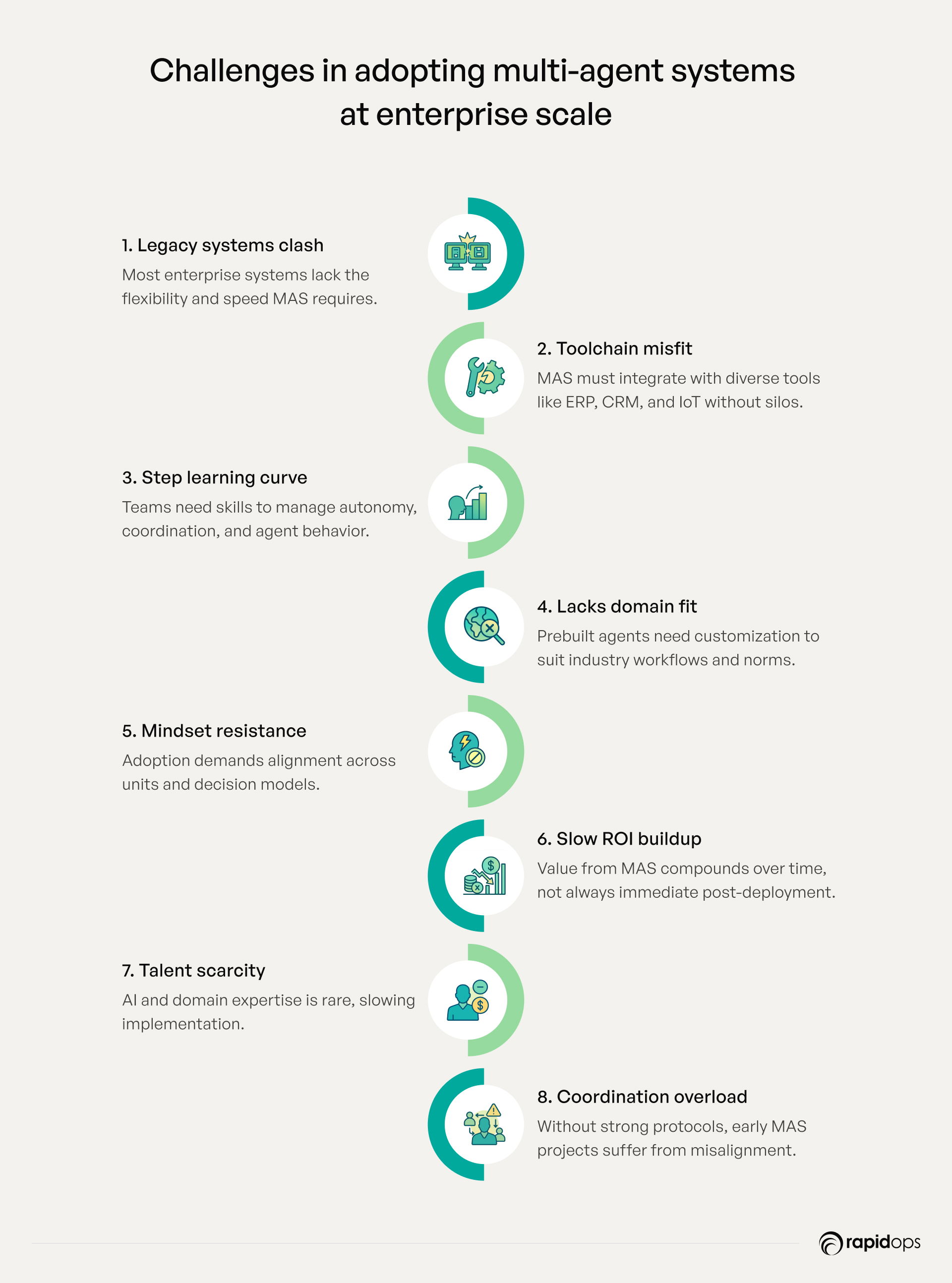
1. Legacy infrastructure
Traditional enterprise systems weren’t built with autonomous, AI-driven agents in mind. Most lack the modularity, data accessibility, or real-time responsiveness that Multi-agent systems requires. Retrofitting such environments involves bridging incompatible systems, modernizing data flows, and enabling flexible integration, without disrupting mission-critical operations that still rely on legacy platforms.
2. Compatibility with enterprise tools and platforms
Multi-agent systems must seamlessly integrate with a wide ecosystem of enterprise applications, ERP, CRM, SCM, IoT platforms, and data lakes. Misalignment between agents and existing tools can create silos or redundancies that limit system effectiveness.
3. Steep initial learning and training curve
Multi-agent systems introduces new models of interaction, autonomy, and coordination that differ from traditional automation systems. Teams must be upskilled to understand agent behaviors, configuration protocols, and governance frameworks, particularly during the early stages of deployment.
4. Customization for domain-specific needs
Out-of-the-box agents often fall short in meeting nuanced, domain-specific workflows. Whether in manufacturing, logistics, or customer operations, tailoring agents to align with industry logic and compliance requirements can be a complex and time-intensive process.
5. Change management and stakeholder alignment
Adopting multi-agent systems isn’t just a technical shift; it’s a mindset change. Business units must align new ways of working, decision-making autonomy, and cross-functional collaboration and coordination. Without a strong change management strategy, internal resistance can stall progress.
6. Delayed value realization
Unlike traditional automation, multi-agent systems benefits compounds over time as agents learn, adapt, and coordinate more effectively. However, this maturity phase often takes several months, requiring stakeholders to balance short-term expectations with long-term outcomes.
7. Shortage of skilled talent
Implementing multi-agent systems at scale demands a blend of AI, system architecture, and process expertise talent that remains scarce across industries. Building the right team or partnering with experienced solution providers becomes essential to avoid execution risk.
8. Managing agent coordination complexity
Early-stage deployments frequently struggle with ensuring smooth coordination among agents, particularly when confronted with conflicting goals or incomplete data. It is critical to define robust protocols for communication, decision arbitration, and fallback mechanisms is critical.
Unlock the power of multi-agent systems for your business
As enterprise operations become more distributed and fast-moving, the challenge isn’t just automation; it’s intelligent coordination. That’s where multi-agent systems make the difference. These AI agents don’t just execute, they sense, decide, and collaborate in real time to keep your operations agile, aligned, and future-ready.
Whether it’s reducing delays, streamlining workflows, or enabling faster, smarter decisions, multi-agent systems bring intelligence into the flow of work, quietly removing bottlenecks and giving your teams more space to focus on what matters most.
At Rapidops, we help forward-thinking enterprises bring multi-agent systems to life not as a concept, but as a fully integrated layer within their business. From identifying high-impact opportunities to embedding AI agents into your ecosystem, we turn complexity into clarity, speed, and results.
Ready to reimagine how your business runs with AI?
Book a free consultation with our multi-agent systems experts to explore how intelligent coordination can help you operate smarter, scale faster, and stay ahead.
Frequently Asked Questions
How do AI agents collaborate to solve enterprise-level challenges in a multi-agent system?
AI agents in a multi-agent system collaborate by continuously exchanging data, aligning their tasks, and adapting to evolving business contexts. This real-time coordination allows them to break down complex enterprise challenges into manageable parts, optimize resource allocation, and make faster, smarter decisions together. By working as an intelligent, interconnected network, these agents drive seamless operations, enhance agility, and unlock scalable solutions across the organization.
How does a multi-agent system improve decision-making?
Multi-agent system improves enterprise decision-making by decentralizing intelligence. Each AI agent processes local data, makes independent decisions, and communicates outcomes to peers, accelerating response times and reducing bottlenecks. This enables the enterprise to make faster, context-aware decisions across functions, even in volatile or high-volume environments.
Can multi-agent systems integrate with existing enterprise platforms?
Yes. Multi-agent systems can be layered onto existing enterprise systems like ERPs, CRMs, or IoT platforms via APIs and event-driven architectures. This means organizations can introduce AI-driven autonomy and coordination without overhauling legacy infrastructure, enhancing current capabilities while preserving prior investments.
How do multi-agent systems make AI more scalable?
Multi-agent systems inherently supports scale through distributed architecture. Instead of relying on a central model, enterprises can deploy multiple specialized agents that handle specific tasks across systems or regions. New agents can be added incrementally, allowing businesses to scale AI capabilities in modular, cost-efficient, and fault-tolerant ways.
Are multi-agent systems only for large enterprises, or can mid-sized companies benefit too?
Multi-agent systems are not exclusive to large enterprises; mid-sized companies stand to gain significantly as well. These systems enable mid-sized firms to automate complex workflows, enhance agility, and improve cross-functional coordination without requiring extensive IT resources. With cloud-native multi-agent systems solutions, scaling intelligent automation becomes cost-effective and flexible, empowering mid-sized businesses to compete effectively and innovate rapidly in dynamic markets.

Rahul Chaudhary
Content Writer
With 5 years of experience in AI, software, and digital transformation, I’m passionate about making complex concepts easy to understand and apply. I create content that speaks to business leaders, offering practical, data-driven solutions that help you tackle real challenges and make informed decisions that drive growth.
What’s Inside
- What are multi-agent systems? A clear definition
- Single agent vs. multi-agent systems: A strategic comparison
- Why multi-agent systems matter for modern enterprises
- How multi-agent systems work under the hood
- Types of multi-agent architectures: Centralized, decentralized, and hybrid
- How AI agents coordinate, communicate, and evolve together
- Real-time learning and adaptation in multi-agent systems
- Industry applications of multi-agent systems
- Challenges enterprises face when adopting multi-agent systems
- Unlock the power of multi-agent systems for your business

Let’s build the next big thing!
Share your ideas and vision with us to explore your digital opportunities
Similar Stories
- AI
- 4 Mins
- September 2022

- AI
- 9 Mins
- January 2023


Receive articles like this in your mailbox
Sign up to get weekly insights & inspiration in your inbox.
